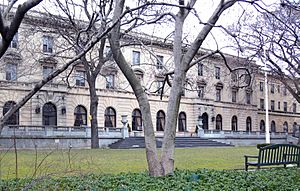Andrew Freedman facts for kids
Quick facts for kids
Andrew Freedman
|
|
|---|---|
 |
|
| Born | September 1, 1860 New York City, New York, U.S.
|
| Died | December 4, 1915 (aged 55) New York City, New York, U.S.
|
| Occupation |
|
Andrew Freedman (born September 1, 1860 – died December 4, 1915) was a smart American businessman. He is best known for owning the New York Giants baseball team from 1895 to 1902. He also briefly owned the Baltimore Orioles in 1902. That team later moved and became the famous New York Yankees. Freedman was also a director for important companies. These included the Interborough Rapid Transit Company, which ran New York City's subway, and the Wright Company, which made airplanes. He was born and passed away in New York City.
About Andrew Freedman
Andrew Freedman was born in New York City on September 1, 1860. His family were German-Jewish immigrants. They were a middle-class family. He went to a public school in Lower Manhattan. It was called Grammar School No. 35. He also studied at City College of New York.
Baseball Team Owner
In 1895, Andrew Freedman became the main owner of the New York Giants. This was a team in the National League (NL). He bought a big part of the team for about $53,000. This amount would be worth much more today.
During his time as owner, Freedman often made his players upset. He would fine them for different reasons. In one famous event, a star pitcher named Amos Rusie refused to play. He sat out the entire 1896 season because of a disagreement with Freedman. Some important people in baseball, like Al Spalding, even said Freedman should leave the game. But Freedman did not agree.
In 1902, Freedman bought a major part of the Baltimore Orioles team. This team was in the rival American League (AL). He did this with money from John T. Brush, who owned the Cincinnati Reds. The Orioles team was in a lot of debt.
Freedman then did something surprising. He let the Orioles' best players leave their contracts. This meant they could sign with teams in the National League. For example, some players joined the Reds. Others, like John McGraw, joined Freedman's own Giants team.
The president of the American League, Ban Johnson, was very angry. He and other owners took control of the Orioles team. The team even had to stop playing a game because they didn't have enough players. In 1903, the Orioles team moved to New York City. They were renamed the Highlanders. Since 1913, this team has been known as the New York Yankees.
At the end of September 1902, Freedman sold the Giants team to John T. Brush.
Other Business Interests
Andrew Freedman was involved in many different businesses. He took over the Manhattan Athletic Club in 1893. This club was having financial problems.
He was also a director for the Interborough Rapid Transit Company (IRT). This company built and ran New York City's first subway system. Freedman invested a lot of money in the company. He also served on the board of directors for the Wright Company. This company was started in 1909 to sell the Wright brothers' airplanes in the United States.
Freedman even owned a special boat called an ice yacht. It was named "Haze." This ice yacht won a race in North Shrewsbury, New Jersey.
His Death and Legacy
Andrew Freedman passed away in New York City on December 4, 1915. He was not married. His estate, or everything he owned, was worth over $4 million. This was a very large amount of money at the time.
In his will, Freedman left money to build the Andrew Freedman Home. This building is located at 1125 Grand Concourse in The Bronx. The home was meant to be a place for people to live when they retired. Plans for the building were made in 1922. The home cost about $1 million to build and opened in 1924. The Andrew Freedman Home was named a New York City Designated Landmark in 1992.


